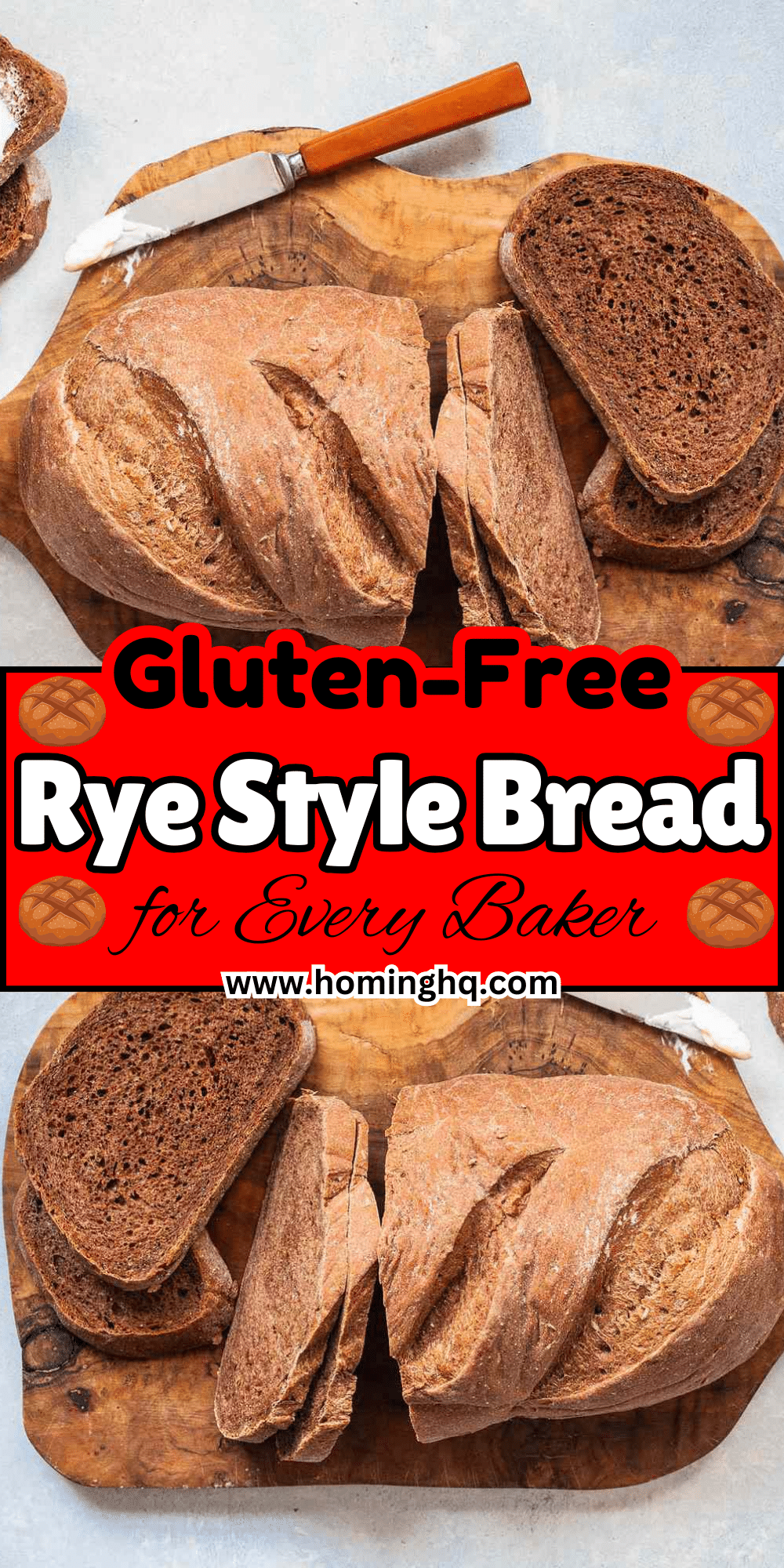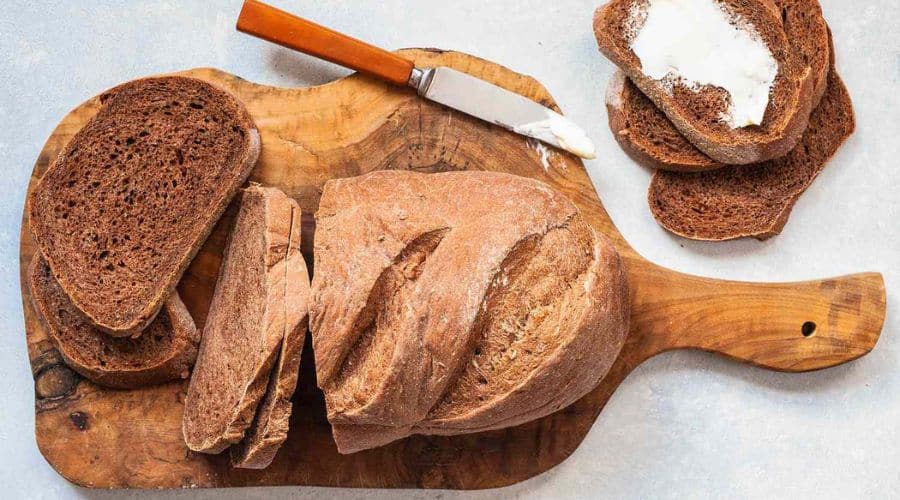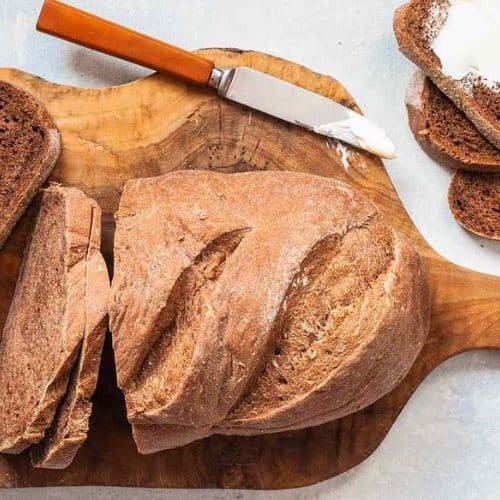All products are selected by our editorial team for quality. If you buy through our links, we may earn a small commission at no extra cost to you.
Rye bread is known for its deep, earthy flavor, slightly dense texture, and subtle sweetness.
However, traditional rye bread is not suitable for those following a gluten-free diet.
That’s where this Gluten-Free Rye-Style Bread comes in—offering the same rich taste and hearty feel without the gluten.
This recipe is designed to replicate the signature characteristics of rye bread using a blend of gluten-free flours, caraway seeds, and a few secret ingredients to enhance both texture and taste.
Whether you’re celiac, gluten-sensitive, or simply looking for a nutritious homemade bread alternative, this recipe will become a staple in your kitchen.
Get ready to enjoy a slice of warm, flavorful bread perfect for sandwiches, toast, or simply with a smear of butter!

Why Make a Gluten-Free Rye-Style Bread?
A Great Alternative for Those Avoiding Gluten
Traditional rye bread contains rye flour, which has gluten, making it off-limits for individuals with celiac disease or gluten intolerance.
This gluten-free version allows you to enjoy the familiar taste and texture while staying within dietary restrictions.
Mimicking the Classic Rye Bread Flavor
Many people assume that without rye flour, it’s impossible to achieve that signature rye taste.
However, this recipe uses caraway seeds, cocoa powder, and a hint of molasses to replicate the depth and complexity of rye bread—without the gluten.
Packed with Nutrients and Fiber
Unlike many store-bought gluten-free breads, which can be starchy and lacking in nutrients, this homemade version incorporates fiber-rich flours like sorghum, brown rice, or oat flour.
These ingredients not only add structure but also make this bread a more nutritious choice.
Perfect for Sandwiches, Toast, and More
This gluten-free rye-style bread holds up well when sliced, making it a fantastic option for sandwiches, open-faced toasts, and even croutons.
It’s a versatile bread that can easily become a go-to for both everyday meals and special occasions.
Key Ingredients for the Perfect Rye Flavor Without Rye
1. A Well-Balanced Gluten-Free Flour Blend
To achieve the right texture, a mix of brown rice flour, sorghum flour, and oat flour works best.
These flours provide structure, a mild nuttiness, and enough density to resemble traditional rye bread without being too heavy.
2. Caraway Seeds – The Essential Rye Flavor
Caraway seeds are what make rye bread taste like rye bread. They have a warm, slightly peppery taste with a hint of citrus, giving this gluten-free version its signature flavor.
3. Cocoa Powder or Instant Coffee for Deep Color and Taste
A small amount of unsweetened cocoa powder or instant coffee adds the deep, slightly earthy tone that mimics traditional dark rye bread.
It doesn’t make the bread taste like chocolate or coffee—just enhances the richness.
4. Molasses or Maple Syrup for Subtle Sweetness
Molasses is a classic ingredient in many rye bread recipes, adding a touch of sweetness and depth.
If you prefer a lighter flavor, maple syrup is a great alternative.
5. Psyllium Husk or Xanthan Gum for Elasticity
Since gluten provides structure and elasticity in regular rye bread, a binding agent is necessary for a gluten-free version.
Psyllium husk works best, as it helps trap moisture, preventing the bread from being too dry.
Xanthan gum can also be used to improve dough elasticity.
6. Yeast for a Light and Airy Texture
To get a proper rise and avoid a dense loaf, yeast is essential.
Using active dry yeast or instant yeast will help the dough develop a soft and airy crumb.
These ingredients work together to create a gluten-free bread that closely resembles the taste, texture, and heartiness of traditional rye bread—all while being completely safe for those avoiding gluten.
Would you like me to continue with the next sections?
Step-by-Step Recipe: How to Make Gluten-Free Rye-Style Bread

Ingredients
Dry Ingredients:
- 1 ½ cups brown rice flour
- 1 cup sorghum flour
- ½ cup oat flour (certified gluten-free)
- ¼ cup tapioca starch
- 2 tablespoons psyllium husk powder (or 1 teaspoon xanthan gum)
- 2 teaspoons caraway seeds
- 1 tablespoon unsweetened cocoa powder (or instant coffee)
- 1 teaspoon salt
Wet Ingredients:
- 1 ¼ cups warm water (110°F)
- 2 teaspoons molasses (or maple syrup)
- 1 packet (2 ¼ teaspoons) active dry yeast
- 2 tablespoons olive oil or melted butter
- 1 teaspoon apple cider vinegar
Instructions
1. Activate the Yeast
In a small bowl, combine warm water, molasses, and yeast.
Stir gently and let it sit for about 5-10 minutes, or until it becomes foamy.
This step ensures the yeast is active and ready to help the bread rise.
2. Mix the Dry Ingredients
In a large mixing bowl, whisk together brown rice flour, sorghum flour, oat flour, tapioca starch, psyllium husk, caraway seeds, cocoa powder, and salt.
This blend provides the right texture and depth of flavor to mimic traditional rye bread.
3. Combine Wet and Dry Ingredients
Add the yeast mixture, olive oil, and apple cider vinegar to the dry ingredients.
Stir until a sticky dough forms. If using a stand mixer, mix on medium speed for 3-5 minutes.
4. Let the Dough Rise
Transfer the dough to a greased bowl, cover it with a clean towel, and let it rest in a warm place for 60-90 minutes, or until it doubles in size.
5. Shape and Second Rise
Lightly grease a 9×5-inch loaf pan.
Transfer the dough into the pan, smoothing the top with wet hands.
Cover and let it rise for another 30-40 minutes.
6. Bake the Bread
Preheat the oven to 375°F (190°C). Place the loaf in the oven and bake for 40-45 minutes, or until it has a deep golden brown crust and sounds hollow when tapped.
7. Cool and Enjoy
Remove the bread from the oven and let it cool in the pan for 10 minutes before transferring it to a wire rack.
Allow it to cool completely before slicing to achieve the best texture.
Baking Tips for the Best Texture and Taste
1. Use Psyllium Husk for a Better Structure
Psyllium husk absorbs moisture and acts like gluten, giving the bread a soft yet structured texture. It also helps prevent a crumbly loaf.
2. Let the Dough Fully Rise
Since gluten-free bread lacks the elasticity of wheat-based doughs, proper rising time is crucial.
Allowing the dough to double in size ensures a lighter and airier crumb.
3. Don’t Skip the Caraway Seeds
Caraway seeds are key to getting that authentic rye bread flavor.
If you’re not a fan of their strong taste, you can slightly reduce the amount, but don’t leave them out entirely.
4. Bake at the Right Temperature
A too-low temperature can result in a dense loaf, while too high can cause over-browning before the inside is fully baked.
Stick to 375°F (190°C) for the best balance.
5. Allow the Bread to Cool Completely
Gluten-free bread needs time to set after baking. Cutting it too soon can make it gummy. Let it cool for at least 2 hours before slicing for the best texture.
Would you like me to continue with the next sections?
Serving Suggestions and Pairings
1. Classic Butter and Jam
A warm slice of gluten-free rye-style bread with butter and a touch of jam makes for a comforting breakfast or snack.
Try it with orange marmalade, raspberry preserves, or honey for a naturally sweet contrast to its earthy flavor.
2. Perfect for Sandwiches
This bread holds up well when sliced, making it a fantastic base for sandwiches. Some great combinations include:
- Reuben Sandwich – Layer with corned beef, Swiss cheese, sauerkraut, and gluten-free Russian dressing.
- Avocado & Smoked Salmon Toast – Spread mashed avocado, add smoked salmon, and top with fresh dill.
- Hummus & Roasted Veggies – A plant-based option with roasted bell peppers, zucchini, and a drizzle of tahini.
3. Toasted with Savory Toppings
Toast a slice and top it with:
- Goat cheese and caramelized onions
- Smashed avocado and poached egg
- Cream cheese and smoked paprika
4. Dipping and Spreading
Use this bread as a dipper for hearty soups or spreads. It pairs wonderfully with:
- Tomato soup
- Lentil stew
- Gluten-free spinach and artichoke dip
5. Make Gluten-Free Croutons or Bread Crumbs
If you have leftover slices, cut them into cubes, toss them with olive oil and seasonings, then bake for homemade croutons. Alternatively, pulse dried slices in a food processor for gluten-free breadcrumbs.
Conclusion
This Gluten-Free Rye-Style Bread brings the rich, hearty flavor of traditional rye bread to those following a gluten-free diet.
With the perfect blend of alternative flours, caraway seeds, and natural ingredients, this bread is both nutritious and delicious.
Whether you enjoy it fresh, toasted, or in a sandwich, this bread is a versatile addition to any meal.
Plus, making it at home ensures you control the ingredients, making it healthier and tastier than most store-bought gluten-free options.
Now it’s time to bake your own loaf!
Try this recipe and let me know in the comments how it turned out.
Have any questions? Check out the FAQs below!
Frequently Asked Questions (FAQs)
1. Can I make this bread without yeast?
Yes! If you prefer a yeast-free version, you can use baking powder and baking soda instead.
However, the texture will be more like a dense quick bread rather than a traditional loaf.
2. How do I store this gluten-free rye-style bread?
Store it in an airtight container at room temperature for up to 3 days.
For longer storage, keep it in the refrigerator for up to a week or freeze slices for up to 3 months.
3. Can I use a bread machine to make this?
Yes, you can use a gluten-free setting on your bread machine. Follow the same ingredient order—liquids first, dry ingredients second, and yeast last.
4. What can I use instead of caraway seeds?
If you don’t like caraway seeds, you can substitute fennel seeds or anise seeds for a similar flavor.
If you prefer a milder taste, you can simply omit them.
5. Can I make this bread nut-free?
Absolutely! This recipe does not contain nuts, but if you are substituting flours, avoid almond flour.
Stick to oat, sorghum, or brown rice flour for a nut-free alternative.

Gluten-Free Rye Style Bread
Equipment
- 9×5-inch loaf pan (1)
- Mixing bowls (2)
- Whisk (1)
- Measuring cups and spoons (1 set)
- Stand mixer or hand mixer (optional)
- Kitchen towel – 1
- Wire Rack: 1
Ingredients
- 1 ½ cups brown rice flour
- 1 cup sorghum flour
- ½ cup oat flour certified gluten-free
- ¼ cup tapioca starch
- 2 tablespoons psyllium husk powder or 1 teaspoon xanthan gum
- 2 teaspoons caraway seeds
- 1 tablespoon unsweetened cocoa powder or instant coffee
- 1 teaspoon salt
- 1 ¼ cups warm water 110°F
- 2 teaspoons molasses or maple syrup
- 1 packet 2 ¼ teaspoons active dry yeast
- 2 tablespoons olive oil or melted butter
- 1 teaspoon apple cider vinegar
Instructions
Activate the Yeast:
- In a small bowl, combine warm water and molasses. Stir in yeast and allow it to proof for 5-10 minutes or until foamy.
Mix the Dry Ingredients:
- In a large mixing bowl, whisk together the brown rice flour, sorghum flour, oat flour, tapioca starch, psyllium husk, caraway seeds, cocoa powder, and salt.
Combine Wet and Dry Ingredients:
- Add the yeast mixture, olive oil, and apple cider vinegar to the dry ingredients. Stir until a sticky dough forms.
Let the Dough Rise:
- Cover the dough with a clean kitchen towel and place it in a warm area to rise for 60-90 minutes, or until it doubles in size.
Shape the Dough:
- Transfer the dough to a greased 9×5-inch loaf pan, smoothing the top with wet hands. Cover and let it rise for another 30-40 minutes.
Bake:
- Preheat the oven to 375°F (190°C). Bake for 40-45 minutes, or until the bread is golden brown and sounds hollow when tapped.
Cool:
- Let the bread cool in the pan for 10 minutes, then transfer it to a wire rack to cool completely before slicing.
Notes
- Storage: Keep the bread in an airtight container at room temperature for up to 3 days. For longer storage, refrigerate it for up to 1 week or freeze slices for up to 3 months.
- Texture: This bread is denser than traditional rye bread, but it should have a soft crumb and crust when properly baked and cooled.
- Substitutions: You can use maple syrup instead of molasses for a lighter sweetness. If you prefer a nut-free version, avoid using oat flour and opt for additional rice or sorghum flour.
- No yeast?: Try using baking powder and baking soda if you prefer a quick bread with a slightly different texture.

